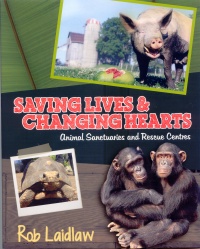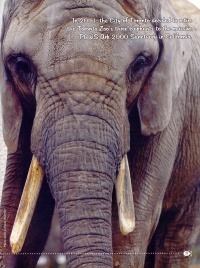| ________________
CM . . .
. Volume XIX Number 23. . . .February 15, 2013 
 |
Saving Lives & Changing Hearts: Animal Sanctuaries and Rescue Centres.
Rob Laidlaw.
Markham. ON: Fitzhenry & Whiteside, 2013.
64 pp., hardcover, $19.95.
ISBN 978-1-55455-212-2.
Subject Headings:
Animal sanctuaries-Juvenile literature.
Wildlife refuges-Juvenile literature.
Animal rescue-juvenile literature.
Human-animal relationships-Juvenile literature.
Grades 4-8 / Ages 9-13.
Review by Gillian Richardson.
***½ /4
|
| |
|

excerpt:
At The Wild Animal Sanctuary, 25 lions enjoy spacious, natural pens. They were part of Operation Lion Ark, the world's biggest ever lion rescue and airlift.
The lions had been removed from inhumane conditions in circuses in the South American country of Bolivia. The rescue was possible because of the work of Animal Defenders International (ADI), which campaigned for a law banning performing animal acts in the country.
It was a great success and the law was passed. The circuses had one year to relocate or give up their animals. Some of them did, but a few defied the law. ADI, in association with the Bolivian government, began enforcing the law and seizing the animals. In just three weeks' time, every remaining circus animal in Bolivia had been confiscated, including the 25 lions.
The lions were airlifted on a DC-10 plane and moved to The Wild Animal Sanctuary, a 720-acre carnivore sanctuary in the United States.
Based on the conviction that "all animals deserve our respect and compassion" and should have "an opportunity to act naturally," Zoocheck founder and president Rob Laidlaw has presented another aspect of animal rights in the latest in his series of books on this topic. Readers are introduced to sanctuaries and rescue centres established worldwide as need arose to protect animals subjected to physical, psychological and social deprivation as a result of human activities. These animals are rescued from the pet and commercial trade, zoos with inadequate facilities, research laboratories, abusive captivity, oil spills and other hazards. While rescue centres have a mission to rehabilitate animals for possible return to the wild, sanctuaries usually become permanent homes to the animals they take in.
 The author offers a snapshot visit to a number of sanctuaries to show why they are needed, how they operate and how they attempt to effect positive changes of attitude. After an introductory glimpse of a sloth bear rescue centre in India, the tour includes refuges for donkeys, farm animals, elephants, Asiatic black bears, lions, chimps, tropical birds, tortoises, and marine birds and mammals. One or more animals in each situation is profiled, and the action for its recovery is described. The success of these ventures shows the merit of the facilities, but realistically not all rescues end happily depending on injuries suffered, and some are in process or remain unresolved. Examples of the latter give a sense of immediacy to the stories but are presented in an objective manner. Readers can browse the list of accredited organizations and are encouraged to consider personal involvement through advocacy, education, donation and volunteerism. One chapter is devoted to explaining how some sanctuaries are not legitimate, hence the need for a global association to ensure professional standards are met. Another chapter outlines what must be considered when setting up a sanctuary: people, money, organization, facilities, security, the future of the animals in care. These last two chapters attest to the commitment and dedication of people involved in this kind of enterprise. A double-page spread of endorsements for this book, and review excerpts from Laidlaw's previous two books are included. There is no bibliography, however. The author offers a snapshot visit to a number of sanctuaries to show why they are needed, how they operate and how they attempt to effect positive changes of attitude. After an introductory glimpse of a sloth bear rescue centre in India, the tour includes refuges for donkeys, farm animals, elephants, Asiatic black bears, lions, chimps, tropical birds, tortoises, and marine birds and mammals. One or more animals in each situation is profiled, and the action for its recovery is described. The success of these ventures shows the merit of the facilities, but realistically not all rescues end happily depending on injuries suffered, and some are in process or remain unresolved. Examples of the latter give a sense of immediacy to the stories but are presented in an objective manner. Readers can browse the list of accredited organizations and are encouraged to consider personal involvement through advocacy, education, donation and volunteerism. One chapter is devoted to explaining how some sanctuaries are not legitimate, hence the need for a global association to ensure professional standards are met. Another chapter outlines what must be considered when setting up a sanctuary: people, money, organization, facilities, security, the future of the animals in care. These last two chapters attest to the commitment and dedication of people involved in this kind of enterprise. A double-page spread of endorsements for this book, and review excerpts from Laidlaw's previous two books are included. There is no bibliography, however.
Saving Lives & Changing Hearts is well-illustrated with photographs, many taken by Laidlaw and others by those who run the sanctuaries. The layout is made interesting with a variety of type styles, colors and background patterns all of which add eye-appeal – with the exception of pages 28-29 where the background of dried savannah grass obscures the type somewhat.
Readership covers a wide range. The details of Sanctuary Principles (page 1) and the facts about Global Federation of Animal Sanctuaries (pages 51-52) are complex enough to require capable reading and comprehension skills, while the stories of individual animals and the suggestions for becoming involved (Become A Sanctuary & Rescue Centre Hero) are more suited to a younger audience. The book will be best used by parents and children together to facilitate discussion. Such activity would address its purpose of enhancing understanding of the need, as the title suggests, to 'save lives and change hearts.'
Highly Recommended.
Gillian Richardson is a freelance writer living in BC.

To comment
on this title or this review, send mail to cm@umanitoba.ca.
Copyright © the Manitoba Library Association. Reproduction for personal
use is permitted only if this copyright notice is maintained. Any
other reproduction is prohibited without permission.
NEXT REVIEW |
TABLE OF CONTENTS FOR THIS ISSUE
- February 15, 2013.
AUTHORS |
TITLES |
MEDIA REVIEWS |
PROFILES |
BACK ISSUES |
SEARCH |
CMARCHIVE |
HOME |

 The author offers a snapshot visit to a number of sanctuaries to show why they are needed, how they operate and how they attempt to effect positive changes of attitude. After an introductory glimpse of a sloth bear rescue centre in India, the tour includes refuges for donkeys, farm animals, elephants, Asiatic black bears, lions, chimps, tropical birds, tortoises, and marine birds and mammals. One or more animals in each situation is profiled, and the action for its recovery is described. The success of these ventures shows the merit of the facilities, but realistically not all rescues end happily depending on injuries suffered, and some are in process or remain unresolved. Examples of the latter give a sense of immediacy to the stories but are presented in an objective manner. Readers can browse the list of accredited organizations and are encouraged to consider personal involvement through advocacy, education, donation and volunteerism. One chapter is devoted to explaining how some sanctuaries are not legitimate, hence the need for a global association to ensure professional standards are met. Another chapter outlines what must be considered when setting up a sanctuary: people, money, organization, facilities, security, the future of the animals in care. These last two chapters attest to the commitment and dedication of people involved in this kind of enterprise. A double-page spread of endorsements for this book, and review excerpts from Laidlaw's previous two books are included. There is no bibliography, however.
The author offers a snapshot visit to a number of sanctuaries to show why they are needed, how they operate and how they attempt to effect positive changes of attitude. After an introductory glimpse of a sloth bear rescue centre in India, the tour includes refuges for donkeys, farm animals, elephants, Asiatic black bears, lions, chimps, tropical birds, tortoises, and marine birds and mammals. One or more animals in each situation is profiled, and the action for its recovery is described. The success of these ventures shows the merit of the facilities, but realistically not all rescues end happily depending on injuries suffered, and some are in process or remain unresolved. Examples of the latter give a sense of immediacy to the stories but are presented in an objective manner. Readers can browse the list of accredited organizations and are encouraged to consider personal involvement through advocacy, education, donation and volunteerism. One chapter is devoted to explaining how some sanctuaries are not legitimate, hence the need for a global association to ensure professional standards are met. Another chapter outlines what must be considered when setting up a sanctuary: people, money, organization, facilities, security, the future of the animals in care. These last two chapters attest to the commitment and dedication of people involved in this kind of enterprise. A double-page spread of endorsements for this book, and review excerpts from Laidlaw's previous two books are included. There is no bibliography, however.